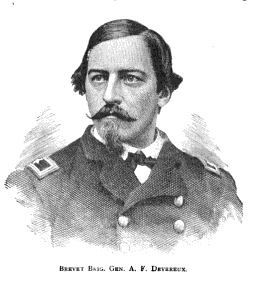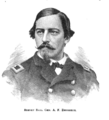Arthur F. Devereux facts for kids
Quick facts for kids
Arthur F. Devereux
|
|
|---|---|
 |
|
| Born | April 27, 1838 Salem, Massachusetts |
| Died | February 13, 1906 (aged 67) Cincinnati, Ohio |
| Place of burial |
Spring Grove Cemetery, Cincinnati, Ohio
|
| Allegiance | Union |
| Service/ |
Union Army |
| Years of service | 1861 – 1864 |
| Rank | |
| Commands held |
|
| Battles/wars | American Civil War |
| Awards | Brevet Brigadier General |
| Other work | Ohio state representative |
Arthur Forrester Devereux (born April 27, 1838 – died February 13, 1906) was an important officer in the Union Army during the American Civil War. He started as a captain in the Massachusetts Volunteer Militia. Later, he became a colonel. Devereux was well-known for being excellent at teaching military drill, which is how soldiers practice marching and movements.
During the famous Battle of Gettysburg, his unit, the 19th Regiment Massachusetts Volunteer Infantry, played a key role. They helped close a dangerous gap in the Union lines during a huge attack called Pickett's Charge. After the war, Devereux was given an honorary rank of brevet brigadier general by President Andrew Johnson.
Contents
Arthur Devereux's Early Life and Training
Arthur Devereux was born in Salem, Massachusetts. He went to Harvard College and also attended the United States Military Academy (West Point). His father, George H. Devereux, was a high-ranking military official in Massachusetts. This likely made Arthur interested in military life too.
Arthur didn't finish his studies at West Point. Instead, around age 15 or 16, he moved to Chicago, Illinois, in 1854 to start a business career.
Learning Military Drills in Chicago
In Chicago, Devereux became business partners with a young man named Elmer E. Ellsworth. Their business wasn't very successful. However, both Devereux and Ellsworth were very good at being peacetime militia soldiers. They joined the Illinois National Guard.
Devereux became an assistant to Major Simon Bolivar Buckner. Both Devereux and Ellsworth were very interested in the "Zouave" method of military drill. Zouaves were French Army units known for their fancy uniforms and very precise, showy drills. American Zouave units copied their uniforms and focused on perfect movements. Ellsworth even formed his own Zouave company called the Chicago Cadets, which Devereux helped supervise. They often worked together to perfect these drills.
Later, during the Civil War, Ellsworth commanded a Zouave regiment. He became one of the first Union Army officers killed in the war.
Leading the Salem Light Infantry
In 1855, Devereux moved back to Massachusetts. In 1859, he was chosen to be captain of the Salem Light Infantry company. This was a respected Massachusetts militia unit that had been around since 1805.
Inspired by Ellsworth's Chicago Cadets, Devereux turned his company into a Zouave unit. He trained them in very precise drills. In 1860, his company performed for the Massachusetts Governor and a large crowd. People said the Salem Light Infantry was "a marvel of precision and exactness."
Arthur Devereux in the Civil War
The Civil War began after the Battle of Fort Sumter on April 12, 1861. Devereux's Salem Light Infantry company was quickly assigned to the 8th Regiment Massachusetts Volunteer Infantry. They were to serve for three months.
Protecting the USS Constitution
On April 21, 1861, Devereux's company, called Company J, was sent to protect the USS Constitution. This famous warship was serving as a training ship in Annapolis, Maryland. It was an important national symbol. To keep it safe from Confederate supporters, the Navy moved the Constitution to New York City with Devereux's company on board.
Afterward, Devereux and his company returned to Maryland. They helped fix railroads and guarded areas outside Baltimore. The 8th Massachusetts finished its service on August 1, 1861.
Leading the 19th Massachusetts Regiment
After his first service ended, Devereux immediately wanted to join a new regiment. On August 22, 1861, he became a lieutenant colonel in the 19th Massachusetts. The regiment's commander, Colonel Edward Winslow Hinks, respected Devereux's drill skills. So, he put Devereux in charge of training the 19th Massachusetts. Devereux even brought in some members of his old Salem Light Infantry company to help teach the drills.
After their first winter guarding areas near Washington, D.C., the 19th Massachusetts joined the II Corps in the Army of the Potomac. Devereux missed the unit's first major battle, the Seven Days Battles, because he was sick.
The unit fought in the Second Battle of Bull Run in August 1862. During the Battle of Antietam in September 1862, the 19th Massachusetts was part of a division that charged Confederate lines. They were almost surrounded and suffered many losses. Lieutenant Colonel Devereux was wounded in this fight. Colonel Hinks was also badly wounded, so Devereux took command of the 19th Massachusetts. He was officially promoted to colonel on November 29, 1862.
Hero at Gettysburg
Colonel Devereux and the 19th Massachusetts played a very important role at the Battle of Gettysburg on July 3, 1863. Confederate forces launched a massive attack called Pickett's Charge. This attack only broke through the Union lines in one small spot along Cemetery Ridge. This spot is now known as the ""high-water mark" of the Confederacy." It was the furthest the Confederates got, and their failure there was a major turning point in the war.
The 19th Massachusetts was positioned right at this "high-water mark." When the Confederate attack hit, a gap opened in the Union line right in front of Devereux's regiment. Seeing the danger, Devereux quickly spoke to the colonel of the 42nd New York, saying, "Mallon, we must move!" At that moment, Major General Winfield S. Hancock rode by. Devereux called out, "They have broken through! Shall I get in there?" Hancock immediately replied, "Go at them!"
The 19th Massachusetts and the 42nd New York rushed together to fill the gap. They entered a chaotic hand-to-hand fight. In this fierce battle, the 19th Massachusetts captured four Confederate regimental flags. Devereux personally delivered these flags to his commander after the battle.
After Gettysburg, Devereux was sent to Massachusetts to help with the draft service. He commanded a military camp on Long Island in Boston Harbor during the fall of 1863.
Leading a Brigade
Devereux returned to the Army of the Potomac in November 1863. He was put in command of the Second Brigade, Second Division, II Corps. He was chosen to lead a dangerous charge during the plans for the Battle of Mine Run on November 30, 1863. Luckily, the attack was called off.
Devereux had to resign from his command on February 27, 1864, due to "important family reasons." On February 21, 1866, President Andrew Johnson nominated Devereux for the honorary rank of brevet brigadier general for his brave service during the war. The U.S. Senate confirmed this award on April 10, 1866.
Family and Life After the War
Around the time he left the army in 1864, Arthur Devereux married Clara Anna Rich. They had three sons and four daughters.
After the war, Arthur Devereux went back to a business career. He worked in Boston, then New York, and finally settled with his family in Cincinnati, Ohio. In Ohio, Devereux became a representative in the state legislature.
His wife, Clara, became a well-known journalist. She wrote for the Cincinnati Commercial Gazette and other newspapers. In 1894, Clara Devereux published Mrs. Devereux's Blue Book of Cincinnati, which was a social register of important people in the city. Her daughter, Marion, later continued her mother's work, writing a social column that was very influential in Cincinnati for many years.
Arthur Devereux died on February 13, 1906. He is buried in Spring Grove Cemetery in Cincinnati.
See also
Images for kids


